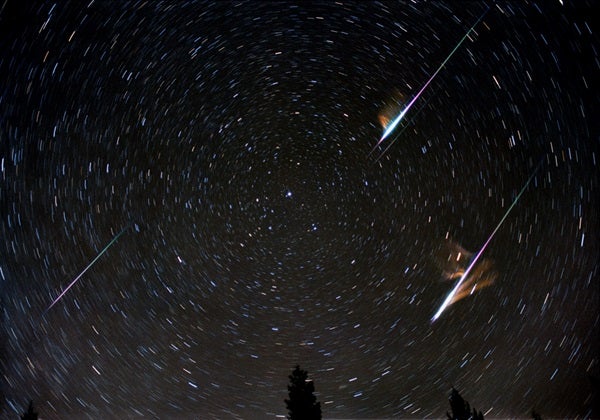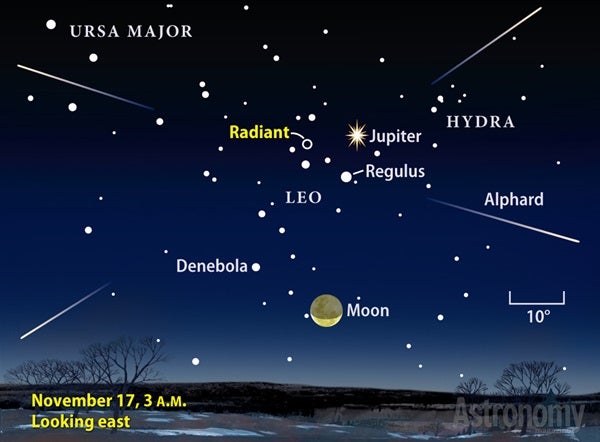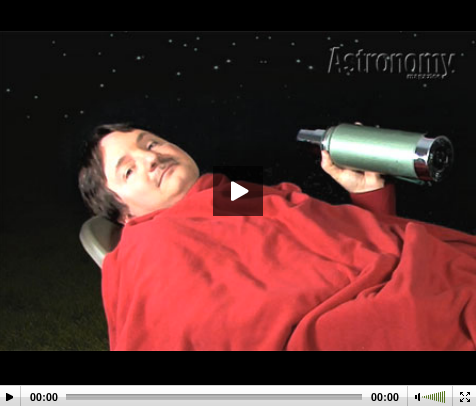This year, the Leonids peak in the evening hours of Monday, November 17. The high point of the shower’s activity should occur around 5 p.m. EST (22h UT). Please note that our chart to the right shows the sky at 3 a.m. on the morning of the peak. We chose that time not for the peak, but rather because we wanted to show the radiant, which doesn’t rise until nearly midnight.
Because of the vagaries involved in calculating several variables, including the density and precise orbit of the particle stream, astronomers who study meteor showers still don’t know exactly how well the shower will perform. Their estimates range from a few streaks up to two dozen meteors per hour at the peak with a “best guess” of 15 per hour.
The Leonids got their name because if one traces all the meteor trails backward, they would meet (at a point called the radiant) within the boundaries of the constellation Leo the Lion. To find Leo in the sky, first locate the Big Dipper, which during November rides high in the northeast around 2 a.m. local time. Leo lies directly south (to the right) of the Dipper’s bowl. The constellation itself rises around local midnight.
Each year at this time, Earth crosses through regions that the shower’s parent comet, 55P/Tempel-Tuttle, visited during previous trips around the Sun. The comet is about 2.5 miles (4 kilometers) in diameter and orbits our star with a period of slightly more than 33 years. And although the peak occurs on the 17th, our planet will encounter debris from Tempel-Tuttle starting November 6 and continuing through the 30th.
Because the Sun vaporizes some of the comet’s ice, the main mass releases dust particles along its path. As our planet runs into these particles, each plunges through the atmosphere super-fast (160,000 mph [258,000 km/h]), creating an incandescent column of gas that we call a meteor.
The high speeds of Leonid meteors mean they produce a greater percentage of fireballs, which are meteors bright enough to cast shadows, than most showers. Most Leonids meet their demise high in Earth’s atmosphere, at altitudes between 50 and 70 miles (85 and 115km); a few bigger particles (approximately the size of a pea) survive to within 12 miles (20km) of the surface. These typically produce fireballs that glow as bright as or brighter than Venus.
Fireballs often leave behind glowing “trains” that can persist for a minute or more. Viewing details in these trains is the main reason to consider bringing binoculars along on your meteor expedition. Otherwise, don’t use optics at all.
Even rich-field telescopes and binoculars limit your field of view, and that’s not good. For a meteor show, you want to see as much of the sky as possible.
This year, the timing of Earth’s passage across the comet’s orbit favors European observers. For them, the radiant will lie high in the sky at the shower’s peak.
Meteor watchers in the Americas can expect to count between a half and two-thirds as many shooting stars as their continental compatriots, mainly due to the fact that the radiant doesn’t rise until close to midnight. On the night of the shower’s peak, the 20-percent-illuminated crescent Moon rises a bit before 2 a.m. local time, so it won’t be much of a factor.
Try to pick your observing site long before November 17. Really, all you need is a dark, accessible location. “Dark” usually means you’re 40 miles (60km) or so from any city. Dress warmly, and consider bringing several blankets. Even in the southern tier of states, mid-November nights are cool. And remember, you won’t be doing anything physical, so your body only will lose heat.
Feel free to snack throughout the night, but I’d caution you about eating too heavily. Doing so tends to make most people tired, and it also will contribute to your feeling cold as your body spends some of its energy on digestion. Warm nonalcoholic drinks will help counteract chilling.
If you do become too tired, stop observing and get some sleep. Even a short nap of 20 to 30 minutes will help you feel refreshed.
Regarding where to look, early in the evening in North America, the radiant will not have risen yet. So, your best bet is to face generally east and look at a point that lies midway between the horizon and overhead. Glancing around won’t hurt anything. If you observe until the wee hours, shift your gaze to the overhead point around midnight.
Finally, don’t look at constellations. Rather, try to see only a random collection of stars. More difficult than this, try not to concentrate on the stars. Just watch the field, not the points of light.
Have fun!
Meteor showers are not “high science,” and they don’t involve keeping your eye, or a camera, glued to a telescope. They’re social events where you and your family or friends can enjoy some bright streaks across a dark sky. Here’s hoping we all see lots of them.
- Video: How to observe meteor showers, with Michael E. Bakich, senior editor
- Video: Easy-to-Find Objects in the 2014 Autumn Sky, with Richard Talcott, senior editor
- StarDome: Locate the shower’s radiant in Leo in your night sky with our interactive star chart.
- The Sky this Week: Get your meteor shower info from a daily digest of celestial events coming soon to a sky near you.
- Sign up for our free weekly email newsletter.













